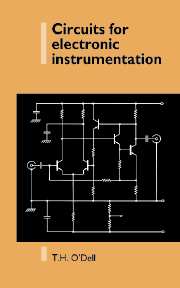Book contents
- Frontmatter
- Contents
- Preface
- 1 Circuits for electronic instrumentation
- 2 Sampling pulse generator circuits
- 3 Sample and hold circuits
- 4 Comparator circuits
- 5 Probes and input circuits
- 6 Wide-band amplifier circuits
- 7 Waveform generator circuits
- 8 Switched capacitor circuits
- 9 Phase locked loop circuits
- 10 Low noise circuits
- Name index
- Subject index
1 - Circuits for electronic instrumentation
Published online by Cambridge University Press: 05 June 2012
- Frontmatter
- Contents
- Preface
- 1 Circuits for electronic instrumentation
- 2 Sampling pulse generator circuits
- 3 Sample and hold circuits
- 4 Comparator circuits
- 5 Probes and input circuits
- 6 Wide-band amplifier circuits
- 7 Waveform generator circuits
- 8 Switched capacitor circuits
- 9 Phase locked loop circuits
- 10 Low noise circuits
- Name index
- Subject index
Summary
Introduction
This book is concerned with the electronic circuits which are found in instrumentation systems. The interest here is with circuit detail. What might be called the ‘difficult’ circuits of instrumentation are those circuits which deal with the signals of interest before these are digitised. These are analog circuits, as a rule, and can involve problems associated with very high frequency technique, low noise level, d.c. stability, and so on.
Electronic instrumentation has developed greatly over the past half century. This development will be reviewed in the next section. Inside the instrument, however, at the level of circuit detail, it is interesting to see how often the same kind of circuit problem comes up again and again. This fact seems to suggest that circuit designers should take some interest in the history of their subject, and have a good knowledge of past technique as well as current technique. For this reason this book gives numerous references to the literature and, when possible, a note is given of the apparent origin of any widely used circuit technique.
The point about circuit detail, a particular circuit idea or what kind of circuit to use, also seems very important in electronic circuit design. It is impossible to calculate component values, device specifications or tolerances, before the circuit shape is fairly well determined.
- Type
- Chapter
- Information
- Circuits for Electronic Instrumentation , pp. 1 - 11Publisher: Cambridge University PressPrint publication year: 1991



